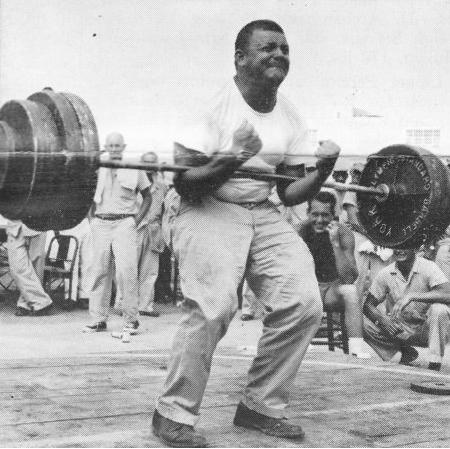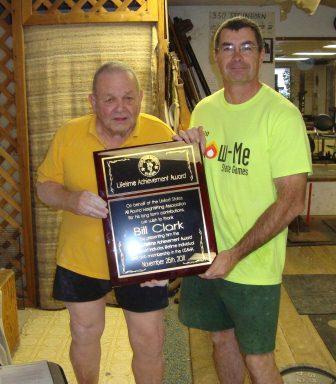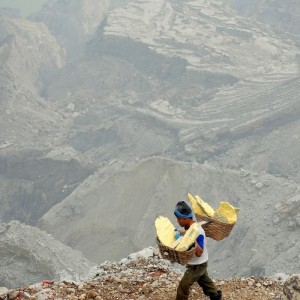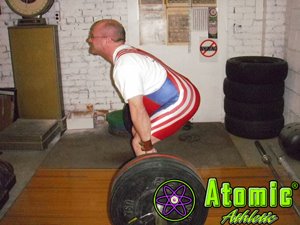Bill Clark – Part 2
by Joe Garcia

Bill Clark performing his favorite lift, the Zercher Lift, at a meet in Leavenworth Prison in the early 1960's. There is 405 pounds on the bar.
Having looked at his role in the USAWA, and it is pretty easy to say there would not be a USAWA without his involvement; it’s time to delve into Bill’s life in general. As we will see, Bill has been immersed in all sorts of sports, but the one in particular which has occupied the majority of his life is baseball.
His professional career as a scout began in 1956 when he became a ‘bird dog’, a person who finds talent for the scouts, for the Milwaukee Braves for $50 per year. He performed at this level until 1962, meanwhile holding other jobs to support his family. The Milwaukee Braves moved to Atlanta in 1966 where they are still today. For a very short period of time he dabbled as an umpire in the Pioneer league, but stated that six weeks in the league cost him 3 years to recover. In 1963 he became the Recreational Director for the city of Columbia and was also called by the Pirates who wanted him to run tryouts. While doing tryouts, he first became a bird dog in their system, later becoming a part time scout and in 1967 was offered and accepted a full time position as scout.
The Seattle Pilots started up as a franchise in 1969 and took Bill on as one of their scouts. The following year they went bankrupt, were purchased and moved to became the Milwaukee Brewers with Bill still on the team. He stayed with them through the 1970 season and in 1971 got on with the Cincinnati Reds, again as a full time scout. In 1984 Marge Schott took over as owner of the Reds. Well known for both her cheapness and her dogs, she had the scouts in for a meeting, charged them 25 cents for leftover donuts from an event the previous day and had them all troupe down to meet her dogs. Needless to say, Bill neither paid for the donuts nor met the dogs.
Probably due to his distain for her dogs, in 1989 Marge fired Bill who then went to work for the Atlanta and stayed with them for ten years. After two years, in 1991, he was promoted to International Director of Scouting, a position he held till 1999 when he was relieved by new management. In 2000, he joined with the San Diego Padres at the same position, where he finished out his scouting career in 2003, again being let go when new management took over the franchise.
During the course of his 36 year tenure in scouting, Bill signed 18 players into the league including Rafael Furcal (Atlanta – $8000) now with the Cardinals (6M), Andruw Jones (Atlanta) now with the Yankees and Bruce Chen (Atlanta) now with the Royals and past Pitcher of the Year. As a member of the teams, he also received World Series rings, and has a total of eight rings, three for the champions; Cincinnati twice and Atlanta once. These are kept in a bank vault, but hopefully he can be persuaded to bring them out sometime to gaze upon.
Way before his scouting and before the Pioneer league, Bill was a Semi-Pro official. In 1949, at the age of 16, he officiated his first ball game for the Kansas City Monarchs, with the immortal Buck O’Neil playing First Base. They kept a friendship going over the years until Buck’s death in 2006. In 1950 he went to officiating school while still a teenager. The last game Bill officiated was in 2009, between the Columbia Firemen and the media All-Stars for an Honor Flight fund raiser. That last game put him behind the plate for a total of 7 decades.
He has worked in twenty two different sports from the local level through international, including an exhibition season in the NBA, National Junior College Wrestling, and State High School basketball. As an athlete, he has competed in 6 decades, with the seventh just around the corner as he turns 80. He was also co-owner of a trotting horse stables for a few years.
Bill received a Writing degree in Journalism in 1958 from the University of Missouri and has been at it ever since. That same year he became the president of the MO State Sportswriters Association, and also accepted a position with the Lexington Kentucky Leader, whom he worked for briefly. For over twenty years, he was on the staff as part time writer for both the Columbia Tribune and the Missourian, writing bowling columns, sports columns and general high school coverage. Currently, he started writing in 2004 for the Columbia Tribune as their lead columnist, and to date has written approximately 1400 articles. During his traveling years, he visited over 50 countries, logged more than 2000 international birds and has written numerous birding articles.
Over the years, Bill has started, created or revamped numerous organizations and events. Here is a list he was able to think of during our interview:
- In 1960 he wrote his first lifting news letter for the Missouri Valley AAU, expanded to write for the Region 8, and finally the USAWA finishing up in 2009.
- Reorganized and revitalized the dormant Missouri Valley AAU.
- Organized prison weightlifting.
- Ran the prison postal championships for 20 years in Weightlifting, Powerlifting and track.
- Created and wrote the constitution for the National Corrections Recreation Association.
- Held the first sanctioned prison meet at Fort Leavenworth Prison city.
- Along with Jim Witt, Homer Brannum and a couple of other ‘goons’; organized Powerlifting into a separate sport from weightlifting. The ‘goons’ is a reference to comments made at the AAU meetings during the discussions.
- Got prisoners full AAU Membership with 100% approval in 1966.
- Responsible for the creation of the National Masters Weightlifting program.
- In 1976 held the first all women’s sanctioned lifting competition. Judy Glenney, a pioneer in women’s weightlifting and many time National champion, got her start at this meet.
- Started up the USAWA and the IAWA.
- Founder of the Heart of America Marathon – at 52 years the fourth oldest continuous Marathon in the country.
- Originator of the Columbia Diamond Council, the largest youth baseball org in the county.
- Creator of the Columbia Track Club, originally for kids now an adult league.
- Organized the Hawthorne Native Plant Society.
- Organized the Columbia Bowling Hall of Fame.
- Help organize Society for American Baseball Research Scouts committee.
- Organized the Columbia Basketball Officials Association.
- Organized the Columbia Baseball Officials Association.
- Tried and failed to organize the professional baseball scouts into a union.
When someone puts as much into sports as Bill has done, over time they have a tendency to be recognized for their efforts. Below is a list of some of the honors bestowed onto Bill.
- Inducted into the Midwest Baseball Scouts Hall of Fame.
- Received the Roland Hemond Award – from SABR for contributions to scouting and research.
- Inducted into the Columbia Bowling Hall of Fame.
- Inducted into the National Powerlifting Hall of Fame.
- Inducted into the National Weightlifting Hall of Fame.
- Inducted into the National Masters Weightlifting Hall of Fame.
- Inducted into the International Weightlifting Federation (IWF) Hall of Fame.
- Inducted into the Pan American Weightlifting Federation Hall of Fame.
- Inducted into the USAWA Hall of Fame.
- Received the USAWA Lifetime Achievement Award.
- Inducted into the Missouri Valley AAU Hall of Fame.
- Inducted into Association of Oldetime Barbell and Strongmen (AOBS) Hall of Fame.
- Inducted into the Narcy Trass Volunteer Hall of Fame from the Show-Me State Games.
- Won Joe Paul award.
- Name Top Zebra by the Central Missouri Basketball Association.
- In January will be awarded with the Legends in Scouting award out in Los Angeles.
- Won numerous other awards.
There is no question that the world of sports has benefited from Bill Clark and his participation in it. The two columns I have written about him have only touched upon the knowledge, trivia and stories from his years of involvement. He has, in old terminology, ‘seen the elephant’. I like to kid him that when he was born, they broke the mold, then beat the hell out of the mold maker, but all joking aside, there is no doubt that Bill is one of a kind man, the likes of we will never see again. Thanks Bill.


